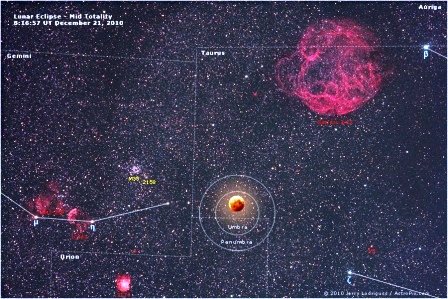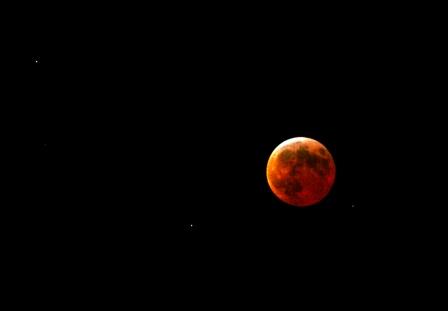With the help of APOD.
And read here.
Sometime after sunset tonight, [The eclipse begins on Tuesday morning, Dec. 21st, at 1:33 am EST (Monday, Dec. 20th, at 10:33 pm PST)] the Moon will go dark. This total lunar eclipse, where the entire Moon is engulfed in the shadow of the Earth, will be visible from all of North America, while the partial phase of this eclipse will be visible throughout much of the rest of the world. Observers on North America’s east coast will have to wait until after midnight for totality to begin, while west coasters should be able to see a fully darkened moon before midnight. Pictured above is a digital prediction, in image form, for how the Moon and the surrounding sky could appear near maximum darkness. Rolling your cursor over the image will bring up labels. Parts of the Moon entering the circle labeled umbra will appear the darkest since the Sun there will be completely blocked by the Earth. Parts of the Moon entering the circle labeled
penumbra will be exposed to some direct sunlight, and so shine by some degree by reflected light. The diminished glare of the normally full Moon will allow unusually good viewings of nearby celestial wonders such as the supernova remnant Simeis 147, the open star cluster M35, and the Crab Nebula M1. By coincidence this eclipse occurs on the day with the shortest amount of daylight in the northern hemisphere — the Winter Solstice. This solstice eclipse is the first in 456 years, although so far it appears that no one has figured out when the next solstice eclipse will be.

One of my photos.




































God’s awesome power and beauty! Thank you for posting the pictures.
Forecast here is for clear skies, and I should be finishing work with plenty of time to enjoy
the show. Thanks for the heads-up, Father.
Unfortunately, after several days of clear skies, we’re going to be clouded over where my family lives. Sad, too, as I was going to wake up my kids to let them see this event.
Perhaps, Fr. Z., you, or some of your readers might post their photographs on-line?
Also probably going to be clouded over here in the Twin Cities as wel. It is predicted that snow will continue through the Monday night Vikings/Bears game relocated to (outdoor) TCF Bank Stadium on the U of M campus after the Metrodome collapsed from the previous snowstorm. That should be fun.
Maybe we’ll get lucky and it will clear out early. I’d love to be able to wake the kids to see the moon “turn to blood.” :) If visible, the peak would happen about 2:15-2:35 a.m. Central time.
The original predictions had the storm dumping most of the snow right on Mpls, but that has been revised.
The last two nights here in the Northeast, the moon has shone full and clear. I hope that it will be the same tonight, so I can see this eclipse.
Oooo, Father Z, your photograph of the ‘red moon’ is awesome!
‘Sun and moon, bless the Lord-praise and exalt Him above all forever’!
I am going to call this celestial event “The Eclipse of Reason” considering world events of the 1550’s through 2010.
+++
alms. fasting. prayer.
Does anyone know why the moon looks red or orange during some lunar eclipses?
Cloudy skies here, but hopefully it will clear up by tonight!
The moon looks redish because of the earth’s atmosphere. The Moon’s light passes through and is scattered by a layer of the Earth’s atmosphere. The shorter wavelengths are more likely to be scattered, so by the time the light has reached our eyes the longer wavelengths dominate — and we see the results as the moon being red.
Here’s a link that explains it better:
http://en.wikipedia.org/wiki/Lunar_eclipse
APOD Editor to Speak in Philly on Jan 5 and NYC on Jan 7
As happens every year around this time, an editor of APOD will be reviewing the Best Astronomy Images for that year in public lectures. This year I will be speaking at two east coast engagements. The first will be in Philadelphia, in the Fels Planetarium at the Franklin Institute on Wednesday, 2011 January 5 at 7:15 pm at the invitation of the Rittenhouse Astronomical Society. For details, please see http://www.rittenhouseastronomicalsociety.org/ and scroll down a bit. In New York City I will be speaking in the Kaufmann Auditorium at the American Museum of Natural History on Friday, 2011 January 7 at 6:15 pm at the invitation of the Amateur Astronomers Association of New York. For details, please see: http://www.aaa.org/lectures1011 . Both events should run for about an hour and will be free for all.
As usual, there have been many spectacular images posted to APOD this year, and it will quite a privilege and thrill for me to review them. I will also review new astronomical discoveries of the year and how they have impacted our understanding of the universe. In past years we have had good turnouts, so please come early to get a good seat. Children are also quite welcome to attend.
– RJN [Robert J. Nemiroff]
I’ve seen from a number of sources that the next solstice total lunar eclipse will occur in 2094. Here’s a Reuter’s article:
http://www.reuters.com/article/idUSTRE6BJ58W20101220
BTW, I have an account of my own experience of the eclipse and spectacular moon effects just prior to it-on my blog, for those who are interested.